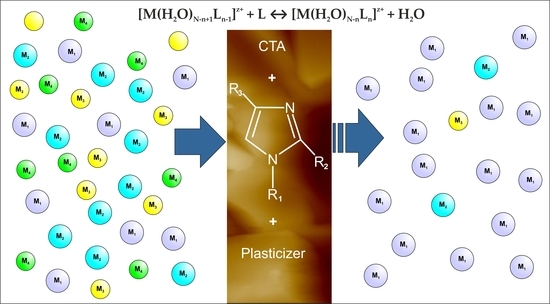Application of Hydrophobic Alkylimidazoles in the Separation of Non-Ferrous Metal Ions across Plasticised Membranes—A Review
Abstract
1. Introduction
2. Properties of Alkylimidazoles
2.1. The 1-Alkylimidazole Moiety as a Carrier
2.2. The 1-Alkyl-2-Methylimidazole and 1-Alkyl-4-Methylimidazole as a Carriers
2.3. The 1-Alkyl-2,4-Dimethylimidazole as a Carrier
3. Complexes of Alkylimidazoles
[M(H2O)6−nLn]2+ ↔ [M(H2O)4−nLn]2+ + 2H2O
4. Transport of Complexes across PIMs
5. Separation of Copper(II)
6. Separation of Zinc(II)
7. Characteristics of Membranes
7.1. SEM Studies of PIMs Doped Alkylimidazoles
7.2. AFM Studies of PIMs Doped Alkylimidazoles
8. Thermal Stability of PIMs Doped Alkylimidazoles
9. Membrane Diffusion Coefficients of Non-Ferrous Metal Ions across PIMs with Alkylimidazoles
10. Other Imidazole Derivatives in the Separation of Metal Ions
11. Conclusions
Author Contributions
Funding
Acknowledgments
Conflicts of Interest
References
- Almeida, M.I.G.S.; Cattrall, R.W.; Kolev, S.D. Recent trends in extraction and transport of metal ions using polymer inclusion membranes (PIMs). J. Membr. Sci. 2012, 415, 9–23. [Google Scholar] [CrossRef]
- Kislik, V.S. (Ed.) Liquid Membranes: Principles and Applications in Chemical Separations and Wastewater Treatment; Elsevier: Burlington, VT, USA, 2010; ISBN 978-0-444-53218-3. [Google Scholar]
- Kuswandi, B.; Nitti, F.; Inês, M.; Almeida, G.S.; Kolev, S.D. Water monitoring using polymer inclusion membranes: A review. Environ. Chem. Lett. 2020, 18, 129–150. [Google Scholar] [CrossRef]
- Zawierucha, I.; Kozlowski, C.A.; Malina, G. Removal of toxic metal ions from landfill leachate by complementary sorption and transport across polymer inclusion membranes. Waste Manag. 2013, 33, 2129–2136. [Google Scholar] [CrossRef] [PubMed]
- Zulkefeli, N.S.W.; Weng, S.K.; Halim, N.S.A. Removal of heavy metals by polymer inclusion membranes. Curr. Pollut. Rep. 2018, 4, 84–92. [Google Scholar] [CrossRef]
- Yaqub, M.; Eren, B.; Eyupoglu, V. Soft computing techniques in prediction Cr(VI) removal efficiency of polymer inclusion membranes. Environ. Eng. Res. 2020, 25, 418–425. [Google Scholar] [CrossRef]
- Drioli, E.; Romano, M. Progress and new perspectives on integrated membrane operations for sustainable industrial growth. Ind. Eng. Chem. Res. 2001, 40, 1277–1300. [Google Scholar] [CrossRef]
- Kolev, S.D.; Almeida, M.I.G.S.; Cattrall, R.W. Polymer Inclusion Membranes, Smart Materials for Sensing and Separation. In Handbook of Smart Materials in Analytical Chemistry; de la Guardia, M., Esteve-Turrillas, F.A., Eds.; John Wiley & Sons Ltd.: Hoboken, NJ, USA, 2019. [Google Scholar] [CrossRef]
- Jha, R.; Rao, M.D.; Meunabh, A.; Verma, R.H.; Singh, K.K. Potential of polymer inclusion membrane process for selective recovery of metal values from waste printed circuit boards: A. review. J. Clean. Prod. 2020, 265, 121621. [Google Scholar] [CrossRef]
- Kislik, V.S. Solvent Extraction: Classical and Novel Approaches; Elsevier: Amsterdam, The Netherlands, 2011; ISBN 978-0-444-53778-2. [Google Scholar]
- Zhang, J.; Hu, B. Liquid-Liquid Extraction (LLE). In Separation and Purification Technologies in Biorefineries; Ramaswamy, S., Huang, H.-J., Ramarao, B.V., Eds.; Wiley & Sons, Ltd.: Hoboken, NJ, USA, 2013. [Google Scholar] [CrossRef]
- Silva, J.E.; Paiva, A.P.; Soares, D.; Labrincha, A.; Castro, F. Solvent extraction applied to the recovery of heavy metals from galvanic sludge. J. Hazard. Mat. 2005, 120, 113–118. [Google Scholar] [CrossRef]
- Kołtuniewicz, A.B.; Drioli, E. Membranes in Clean Technologies; Wiley-VchVerlag GmBH: Weinheim, Germany, 2008; ISBN 978-3-527-32007-3. [Google Scholar]
- Abdul-Halim, N.-S.; Whitten, P.G.; Nghiem, L.D. Characterising poly (vinyl chloride)/Aliquat 336 polymer inclusion membranes: Evidence of phase separation and its role in metal extraction. Sep. Puryf. Technol. 2013, 119, 14–18. [Google Scholar] [CrossRef]
- Almeida, M.I.G.S.; Cattrall, R.W.; Kolev, S.D. Polymer inclusion membranes (PIMs) in chemical analysis—A review. Anal. Chim. Acta 2017, 987, 1–14. [Google Scholar] [CrossRef] [PubMed]
- Vázquez, M.I.; Romero, V.; Fontàs, C.; Anticó, E.; Benavente, J. Polymer inclusion membranes (PIMs) with the ionic liquid (IL) Aliquat 336 as extractant: Effect of base polymer and IL concentration on their physicalchemical and elastic characteristics. J. Membr. Sci. 2014, 455, 312–319. [Google Scholar] [CrossRef]
- Onac, C.; Korkmaz Alpoguz, H.; Akcylen, E.; Yilmaz, M. Facilitated transport of Cr(VI) through polymer inclusion membrane system containing calix[4]arene derivative as carrier agent. J. Macromol. Sci. A 2013, 50, 1013–1021. [Google Scholar] [CrossRef]
- Ugur, A.; Sener, I.; Hol, A.; Alpoguz, H.K.; Elci, L. Facilitated transport of Zn(II) and Cd(II) ions through polymer inclusion membranes immobilized with a calix[4]resorcinarene derivative. J. Macromol. Sci. A 2014, 51, 611–618. [Google Scholar] [CrossRef]
- Baczynska, M.; Regel-Rosocka, M.; Nowicki, M.; Wisniewski, M. Effect of the structure of the polymer inclusion membranes on Zn(II) transport from chloride aqueous solution. J. Appl. Polym. Sci. 2015, 132, 42319. [Google Scholar] [CrossRef]
- Pereira, N.; St John, A.; Cattrall, R.W.; Perera, J.M.; Kolev, S.D. Influence of the composition of polymer inclusion membranes on their homogeneity and flexibility. Desalination 2009, 236, 327–333. [Google Scholar] [CrossRef]
- Nghiem, L.D.; Mornane, P.; Potter, I.D.; Perera, J.M.; Catrall, R.W.; Kolev, S.D. Extraction and transport of metal ions and small organic compounds using polymer inclusion membranes (PIMs). J. Membr. Sci. 2006, 281, 7–41. [Google Scholar] [CrossRef]
- Fontàs, C.; Tayeb, R.; Tingry, S.; Hidalgo, M.; Seta, P. Transport of platinum(IV) through supported liquid membrane (SLM) and polymeric plasticized membrane (PPM). J. Membr. Sci. 2005, 263, 96–102. [Google Scholar] [CrossRef]
- Yang, X.J.; Fane, A.G.; Soldenhoff, K. Comparison of Liquid Membrane Processes for Metal Separations: Permeability, Stability, and Selectivity. Ind. Eng. Chem. Res. 2003, 42, 392–403. [Google Scholar] [CrossRef]
- Ncib, S.; Barhoumi, A.; Bouguerra, W.; Larchet, C.; Dammak, L.; Hamrouni, B.; Elaloui, E. Copper(II) Removal from Synthetic Wastewater Solutions Using Supported Liquid Membrane and Polymer Inclusion Membrane. J. Environ. Eng. 2020, 146, 04019113. [Google Scholar] [CrossRef]
- Regel-Rosocka, M.; Alguacil, F.J. Recent trends in metal extraction. Revista de Metalurgia 2013, 49, 292–316. [Google Scholar] [CrossRef]
- Peaeson, R.G. Hard and soft acids and bases-the evolution of a chemical concept. Coord. Chem. Rev. 1990, 100, 403–425. [Google Scholar] [CrossRef]
- Bougeard, D.; Le Calvé, N.; Saint Roch, B.; Novak, A. 1,2,4-Triazole: Vibrational spectra, normal coordinate calculations, and hydrogen bonding. J. Chem. Phys. 1976, 64, 5152–5164. [Google Scholar] [CrossRef]
- Bauman, J.E., Jr.; Wang, J.C. Imidazole Complexes of Nickel(II), Copper(II), Zinc(II), and Silver(I). Inorg. Chem. 1964, 3, 368–373. [Google Scholar] [CrossRef]
- Sundberg, R.J.; Martin, R.B. Interactions of histidine and other imidazole derivatives with transition metal ions in chemical and biological systems. Chem. Rev. 1974, 74, 471–517. [Google Scholar] [CrossRef]
- Rao, G.N.; Li, N.C. Preparation and characterization of some binary and ternary metal complexes of imidazole and amino acids. Can. J. Chem. 1966, 44, 1637–1641. [Google Scholar] [CrossRef]
- Godlewska, S.; Jezierska, J.; Baranowska, K.; Augustin, E.; Dołęga, A. Copper(II) complexes with substituted imidazole and chlorido ligands: X-ray, UV–Vis, magnetic and EPR studies and chemotherapeutic potential. Polyhedron 2013, 65, 288–297. [Google Scholar] [CrossRef]
- Soayed, A.A.; Refaat, H.A.; El-Din, D.A.N. Metal complexes of moxifloxacin–imidazole mixed ligands: Characterization and biological studies. Inorg. Chim. Acta 2013, 406, 230–240. [Google Scholar] [CrossRef]
- Pekel, N.; Güven, O. Separation of heavy metal ions by complexation on poly (N-vinyl imidazole) hydrogels. Polym. Bull. 2004, 51, 307–314. [Google Scholar] [CrossRef]
- Ajji, Z.; Ali, A.M. Separation of copper ions from iron ions using PVA-g-(acrylic acid/N-vinyl imidazole) membranes prepared by radiation-induced grafting. J. Hazard. Mat. 2010, 173, 71–74. [Google Scholar] [CrossRef]
- Lenarcik, B.; Ojczenasz, P. Investigation of the Stability Constants of Co(II) Complexes with a Homologous Series of 1-Alkylimidazoles in Aqueous Solution by Using a Partition Method with Several Solvents. Sep. Sci. Technol. 2004, 39, 199–226. [Google Scholar] [CrossRef]
- Lenarcik, B.; Rauckyte, T. The Influence of Alkyl Length on Extraction Equilibria of Ni(II) Complexes with 1-Alkylimidazoles in Aqueous Solution/Organic Solvent Systems. Sep. Sci. Technol. 2004, 39, 3353–3372. [Google Scholar] [CrossRef]
- Radzyminska-Lenarcik, E. Search for the possibility of utilizing the differences in complex-forming capacities of alkylimidazoles for selective extraction of some metal ions from aqueous solutions. Pol. J. Chem. Technol. 2008, 10, 73–78. [Google Scholar] [CrossRef]
- Lenarcik, B.; Kierzkowska, A. The Influence of Alkyl Length on Stability Constants of Zn(II) Complexes with 1-Alkylimidazoles in Aqueous Solutions and Their Partition Between Aqueous Phase and Organic Solvent. Solvent Ext. Ion Exch. 2004, 22, 449–471. [Google Scholar] [CrossRef]
- Radzyminska-Lenarcik, E. The influence of the alkyl chain length on extraction equilibrium of Cu(II) complexes with 1-alkylimidazole in aqueous solution/organic solvent system. Solvent Ext. Ion Exch. 2006, 25, 53–64. [Google Scholar] [CrossRef]
- Lenarcik, B.; Kierzkowska, A. The Influence of Alkyl Chain Length and Steric Effect on Extraction of Zinc(II) Complexes with 1-Alkyl-2-methylimidazoles. Solvent Ext. Ion Exch. 2006, 24, 433–445. [Google Scholar] [CrossRef]
- Lenarcik, B.; Barszcz, B. Stability and structure of transition metal complexes with azoles in aqueous solutions, Part XXI. A comparison of complex-forming of 1,2-dimethylimidazole with that of other 1,3-diazoles. J. Chem. Soc. Dalton Trans. 1980, 24–28. [Google Scholar] [CrossRef]
- Lenarcik, B.; Kierzkowska, A. The Influence of Alkyl Chain Length and Steric Effect on Stability Constants and Extractability of Zn(II) Complexes with 1-Alkyl-4(5)-methylimidazoles. Sep. Sci. Technol. 2004, 39, 3485–3508. [Google Scholar] [CrossRef]
- Lenarcik, B.; Ojczenasz, P.; Kopkowski, A. The Influence of the Alkyl Chain Length and Steric Effect on Stability Constants and Extractability of Co(II) Complexes with 1-Alkyl-4(5)-methylimidazoles. Sep. Sci. Technol. 2006, 41, 1697–1724. [Google Scholar] [CrossRef]
- Radzyminska-Lenarcik, E. Influence of the solvent donor number on the O/W partition ratio of Cu(II) complexes of 1,2-dialkylimidazoles. Chem. Pap. 2011, 65, 226–232. [Google Scholar] [CrossRef]
- Lenarcik, B.; Kurdziel, K. Stability and Structure of Transition Metal Complexes of Azoles in Aqueous Solutions, Part XXV. The Effect of the Size and Position of an Alkyl Substituent on the Stability and Structure of Alkylimidazole Complexes. Pol. J. Chem. 1982, 56, 3–14. [Google Scholar]
- Radzyminska-Lenarcik, E. Effect of alkyl chain length on the extraction of Cu(II) complexes with 1-alkyl-2-methylimidazole. Sep. Sci. Technol. 2007, 42, 2661–2675. [Google Scholar] [CrossRef]
- Radzyminska-Lenarcik, E.; Witt, K. The influence of alkyl chain length and steric effect on the stability constants and extractability of Co(II) complexes with 1-alkyl-2-methylimidazoles. Sep. Sci. Technol. 2015, 50, 676–682. [Google Scholar] [CrossRef]
- Radzyminska-Lenarcik, E. Influence of the steric hindrance, ligand hydrophobicity and DN of solvents on structure and extraction of Cu(II) complexes with 1-alkyl-2-ethylimidazole. Sep. Sci. Technol. 2008, 43, 794–814. [Google Scholar] [CrossRef]
- Radzyminska-Lenarcik, E. The influence of alkyl chain length in 1,2-dialkylimidazoles on the extraction capacity and structure of their copper(II) complexes. Sep. Sci. Technol. 2009, 44, 954–970. [Google Scholar] [CrossRef]
- Radzyminska-Lenarcik, E. The influence of steric effect, alkyl chain length and donor number of solvents on the extraction of copper(II) complexes with 1-alkyl-4-methylimidazoles. Solvent Ext. Ion Exch. 2010, 28, 636–652. [Google Scholar] [CrossRef]
- Lenarcik, B.; Kulig, J.; Laider, P. Stability and structure of transition metal complexes with azoles in aqueous solutions, Part II. 2-methylimidazole complexes of Co(II), Cu(II) and Zn(II). Rocz. Chem. 1974, 48, 1151–1158. [Google Scholar] [CrossRef]
- Lenarcik, B.; Kurdziel, K.; Czopek, R. Stability and structure of transition metal complexes with azoles in aqueous solutions. Part XXVIII. The steric effect in the complex formation of 2-n-propylimidazole and 2-isopropylimidazole. Pol. J. Chem. 1991, 65, 815–820. [Google Scholar]
- Lenarcik, B.; Kurdziel, K.; Czopek, R. Stability and structure of transition metal complexes with azoles in aqueous solutions. Part XXIX. The influence of the size and structure of the alkyl group on the formation of 2-alkylimidazole complexes. Pol. J. Chem. 1991, 65, 1235–1241. [Google Scholar]
- Lenarcik, B.; Ojczenasz, P. The Influence of the Size and Position of the Alkyl Groups in Alkylimidazole Molecules on Their Acid—Base Properties. J. Heterocycl. Chem. 2002, 39, 287–290. [Google Scholar] [CrossRef]
- Cupery, M.E. N-Imidazole Compounds and Their Complex Metal Derivatives. U.S. Patent 3,843,667, 22 October 1974. [Google Scholar]
- Schakers, J.M.; du Preez, J.G.H. Solvent Extraction Mixture Comprising Substituted Imidazole or Benzimidazole for the Purification of Groups of Base Metals. U.S. Patent 20040208808, 21 October 2004. [Google Scholar]
- Radzyminska-Lenarcik, E.; Ulewicz, M. Selective transport of Cu(II) across a polymer inclusion membrane with 1-alkylimidazole from nitrate solutions. Sep. Sci. Technol. 2012, 47, 1113–1118. [Google Scholar] [CrossRef]
- Radzyminska-Lenarcik, E.; Ulewicz, M. The use of the steric effect of the carrier molecule in the polymer inclusion membranes for the separation of cobalt(II), nickel(II), copper(II), and zinc(II) ions. Pol. J. Chem. Technol. 2015, 17, 51–56. [Google Scholar] [CrossRef]
- Ulewicz, M.; Radzyminska-Lenarcik, E. Transport of metal ions across polymer inclusion membrane with 1-alkylimidazole. Physicochem. Probl. Miner. Process. 2011, 46, 119–130. [Google Scholar]
- Radzyminska-Lenarcik, E.; Ulewicz, M. The use of 1-alkylimidazoles for selective separation of zinc ions in the transport process across a polymer inclusion membrane. Physicochem. Probl. Miner. Process. 2014, 50, 131–142. [Google Scholar] [CrossRef]
- Radzyminska-Lenarcik, E.; Ulewicz, M. Polymer Inclusion Membranes (PIMs) doped with Alkylimidazole and their Application in the Separation of Non-Ferrous Metal Ions. Polymers 2019, 11, 1780. [Google Scholar] [CrossRef] [PubMed]
- Radzyminska-Lenarcik, E.; Ulewicz, M. The Application of Polymer Inclusion Membranes Based on CTA with 1-alkylimidazole for the Separation of Zinc(II) and Manganese(II) Ions from Aqueous Solutions. Polymers 2019, 11, 242. [Google Scholar] [CrossRef]
- Radzyminska-Lenarcik, E.; Ulewicz, M. Application of polymer and supported membranes with 1-alkyl-2-methylimidazoles for separation of some transition metal ions. Desal. Water Treat. 2017, 64, 425–431. [Google Scholar] [CrossRef]
- Ulewicz, M.; Radzyminska-Lenarcik, E. Supported liquid (SLM) and polymer inclusion (PIM) membranes pertraction of copper(II) from aqueous nitrate solutions by 1-hexyl-2-methylimidazole. Sep. Sci. Technol. 2012, 47, 1383–1389. [Google Scholar] [CrossRef]
- Ulewicz, M.; Radzyminska-Lenarcik, E. Application of supported and polymer membrane with 1-decyl-2-methylimidazole for separation of transition metal ions. Physicochem. Probl. Miner. Process. 2012, 48, 91–102. [Google Scholar]
- Ulewicz, M.; Radzyminska-Lenarcik, E. Application of Polymer and Supported Membranes with 1-Decyl-4-Methylimidazole for Pertraction of Transition Metal Ions. Sep. Sci. Technol. 2014, 49, 1713–1721. [Google Scholar] [CrossRef]
- Ulewicz, M.; Radzyminska-Lenarcik, E. Application of polymer membranes doped with 1-hexyl-4-methylimidazole for pertraction of zinc(II) ions. Physicochem. Probl. Miner. Process. 2015, 51, 447–460. [Google Scholar] [CrossRef]
- Radzyminska-Lenarcik, E.; Ulewicz, R.; Ulewicz, M. Zinc recovery from model and waste solutions using polymer inclusion membrane (PIMs) with 1-octyl-4-methylimidazole. Desal. Water Treat. 2018, 102, 211–219. [Google Scholar] [CrossRef]
- Radzyminska-Lenarcik, E.; Witt, K. The application of membrane extraction in the separation of zinc and cadmium ions. Desal. Water Treat. 2018, 128, 140–147. [Google Scholar] [CrossRef]
- Bjerrum, J. Metal Ammine Formation in Aqueous Solution: Theory of the Reversible Step Reactions, P.; Hasse: Copenhagen, Denmark, 1957. [Google Scholar]
- Lenarcik, B.; Kurdziel, K.; Czopek, R. Search for optimum conditions of extraction of metal complexes with alkylimidazoles, III. Structure—Extractability relationships for 1,4-dimethylimidazole complexes of Co(II), Ni(II), Cu(II), Zn(II), and Cd(II). Solvent Ext. Ion Exch. 1986, 4, 165–182. [Google Scholar] [CrossRef]
- Cieślak-Golonka, M.; Starosta, J.; Wasielewski, M. Wstęp Do Chemii Koordynacyjnej; PWN: Warszawa, Poland, 2010. [Google Scholar]
- Gâzo, J.; Bersuker, I.B.; Garaj, J.; Kabešová, M.; Kohout, J.; Langfelderowá, H.; Melník, M.; Serator, M.; Valach, F. Plasticity of the coordination sphere of Copper(II) complexes, its manifestation and causes. Coord. Chem. Rev. 1976, 19, 253–297. [Google Scholar] [CrossRef]
- Cotton, F.A.; Wilkinson, G.; Gaus, P.L. Chemia Nieorganiczna: Podstawy; PWN: Warszawa, Poland, 2002. [Google Scholar]
- Ceynowa, J. Membrany Selektywne i Procesy Membranowe. In Membrany: Teoria i Praktyka. Pod Red. R.; Wódzki, Fundacja Rozwoju Wydziału Chemii, Uniwersytet Mikołaja Kopernika: Toruń, Poland, 2003. [Google Scholar]
- Walkowiak, W.; Kozłowski, C.; Pellowski, W. Zastosowanie Polimerowych Membran Inkluzyjnych do Wydzielania i Separacji jonów Metali. In Membrany: Teoria i Praktyka. Pod Red. R.; Wódzki, Fundacja Rozwoju Wydziału Chemii, Uniwersytet Mikołaja Kopernika: Toruń, Poland, 2003. [Google Scholar]
- Szymanowski, J. Wybrane Fizykochemiczne Aspekty Wydzielania Jonów Metali. In W: Membrany: Teoria i Praktyka. Pod Red. R.; Wódzki, Fundacja Rozwoju Wydziału Chemii, Uniwersytet Mikołaja Kopernika: Toruń, Poland, 2003. [Google Scholar]
- Danesi, P.R. Separation of metal species by supported liquid membranes. Sep. Sci. Technol. 1984, 19, 857–894. [Google Scholar] [CrossRef]
- Kim, J.S.; Kim, S.K.; Ko, J.W.; Kim, E.T.; Yu, S.H.; Cho, M.H.; Kwon, S.G.; Lee, E.H. Selective transport of cesium ion in polymeric CTA membrane containing calixcrown ethers. Talanta 2000, 52, 1143–1148. [Google Scholar] [CrossRef]
- Kozlowski, C.A.; Walkowiak, W. Applicability of liquid membranes in chromium(VI) transport with amines as ion carriers. J. Membr. Sci. 2005, 266, 143–150. [Google Scholar] [CrossRef]
- Gherrou, A.; Kerdjoudj, H.; Molinari, R.; Seta, P.; Drioli, E. Fixed sites plasticized cellulose triacetate membranes containing crown ethers for silver(I), copper(II) and gold(III) ions transport. J. Membr. Sci. 2004, 228, 149–157. [Google Scholar] [CrossRef]
- Gherrou, A.; Kerdjoudj, H. Specific membrane transport of silver and copper as Ag(CN)32− and Cu(CN)43− ions through a supported liquid membrane using K+-crown ether as a carrier. Desalination 2003, 151, 87–94. [Google Scholar] [CrossRef]
- Arous, O.; Amara, M.; Kerdjoudj, H. Synthesis and characterization of cellulose triacetate and poly(ethylene imine) membranes containing a polyether macrobicyclic: Their application to the separation of copper(II) and silver(I) ions. J. Appl. Polymer Sci. 2004, 93, 1401–1410. [Google Scholar] [CrossRef]
- Xu, J.; Wang, L.; Shen, W.; Paimin, R.; Wang, X. The Influence of the Interior Structure of Aliquat 336/PVC membranes to their extraction behavior. Sep. Sci. Technol. 2005, 39, 3527–3539. [Google Scholar] [CrossRef]
- Gherrou, A.; Kerdjoudj, H.; Molinari, R.; Seta, P. Preparation and characterization of polymer plasticized membranes (PPM) embedding a crown ether carrier application to copper ions transport. Mat. Sci. Eng. C 2005, 25, 436–443. [Google Scholar] [CrossRef]
- Arous, O.; Kerdjoudj, H.; Seta, P. Comparison of carrier-facilitated silver(I) and copper(II) ions transport mechanisms in a supported and in a plasticized cellulose triacetate membrane. J. Membr. Sci. 2004, 241, 177–185. [Google Scholar] [CrossRef]
- Zhai, Y.; Liu, Y.; Chang, X.; Ruan, X.; Liu, J. Metal ion-small molecule complex imprinted polymer membranes: Preparation and separation characteristics. React. Funct. Polym. 2008, 68, 284–291. [Google Scholar] [CrossRef]
- Swaminathan, E.; Nagappan, S.; Rajangam, P.; Dharmalingam, S. Separation of Ni2+, Cu2+ and Cr6+ Metal Ions from Water by Complexation Micro Filtration Technique Using Synthetic Polymer Membranes. Prog. Nanotechnol. Nanomater. 2013, 2, 47–54. [Google Scholar]
- Reece, D.A.; Ralph, S.F.; Wallace, G.G. Metal transport studies on inherently conducting polymer membranes containing cyclodextrin dopants. J. Membr. Sci. 2005, 249, 9–20. [Google Scholar] [CrossRef]
- Wolf, J.R.; Strieder, W. Tortuosities for a random fiber bed: Overlapping, parallel cylinders of several radii. J. Membr. Sci. 1990, 49, 103–115. [Google Scholar] [CrossRef]
- Ulewicz, M.; Szczygelska-Tao, J.; Biernat, J.F. Selectivity of Pb(II) transport across polymer inclusion membranes doped with imidazole azothiacrown ethers. J. Membr. Sci. 2009, 344, 32–38. [Google Scholar] [CrossRef]
- Salazar-Alvarez, G.; Bautista-Flores, A.N.; San Miguel, E.R.; Muhammed, M.; Gyves, J. Transport characterization of a PIM system used for the extraction of Pb(II) using D2EHPA as carrier. J. Membr. Sci. 2005, 250, 247–257. [Google Scholar] [CrossRef]
- Ulewicz, M.; Sadowska, K.; Biernat, J.F. Facilitated transport of Zn(II), Cd(II) and Pb(II) across polymer inclusion membrane doped with imidazole azocrown ethers. Desalination 2007, 214, 352–364. [Google Scholar] [CrossRef]
- Ulewicz, M.; Sadowska, K.; Biernat, J.F. Selective transport of Pb(II) across polymer inclusion membrane using imidazole azocrown ethers as carriers. Physicochem. Probl. Miner. Process. 2007, 41, 133–143. [Google Scholar]

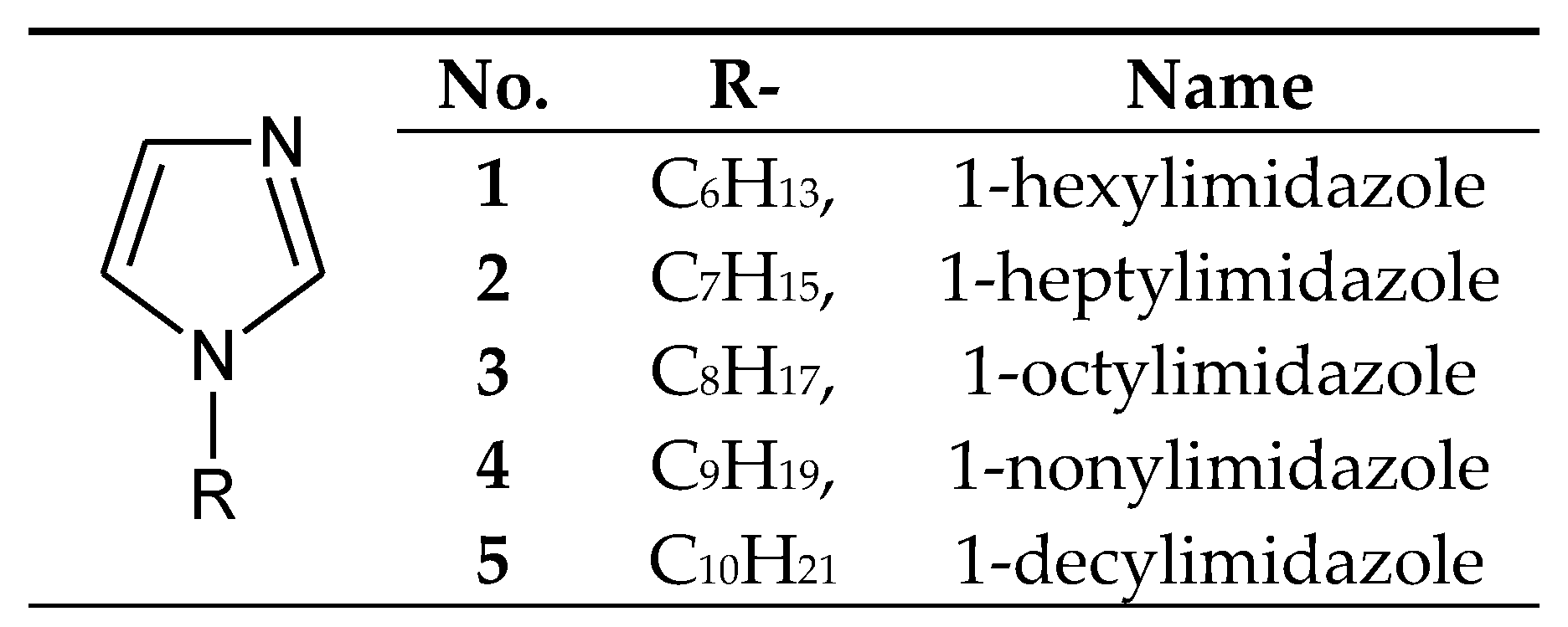


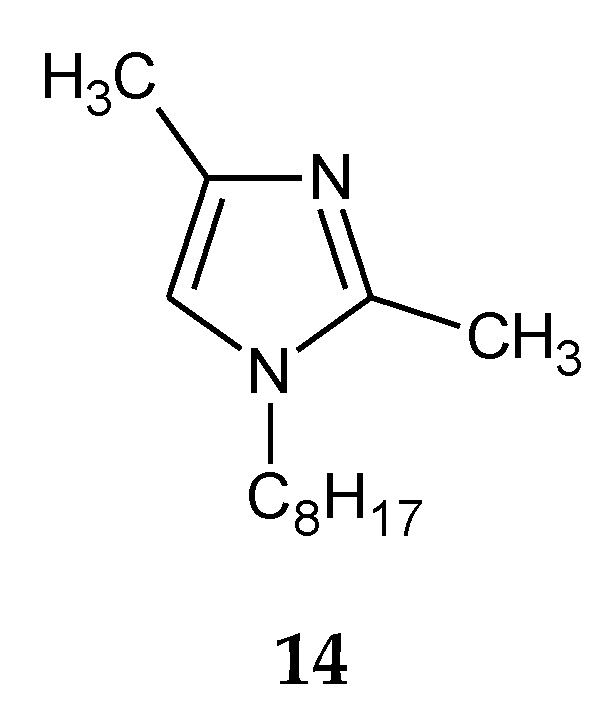
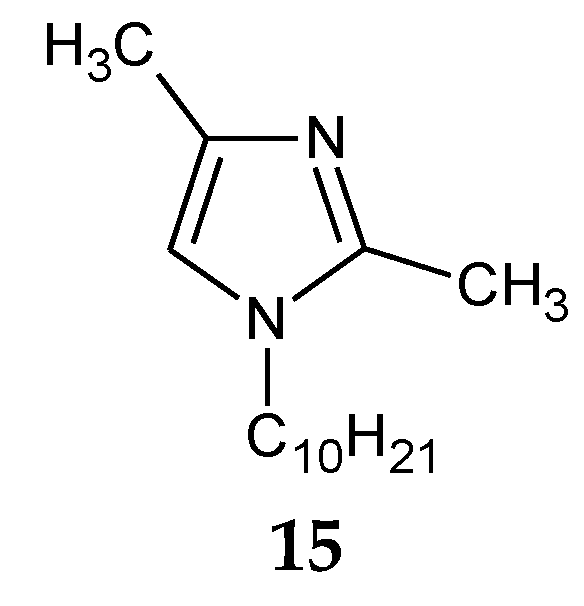
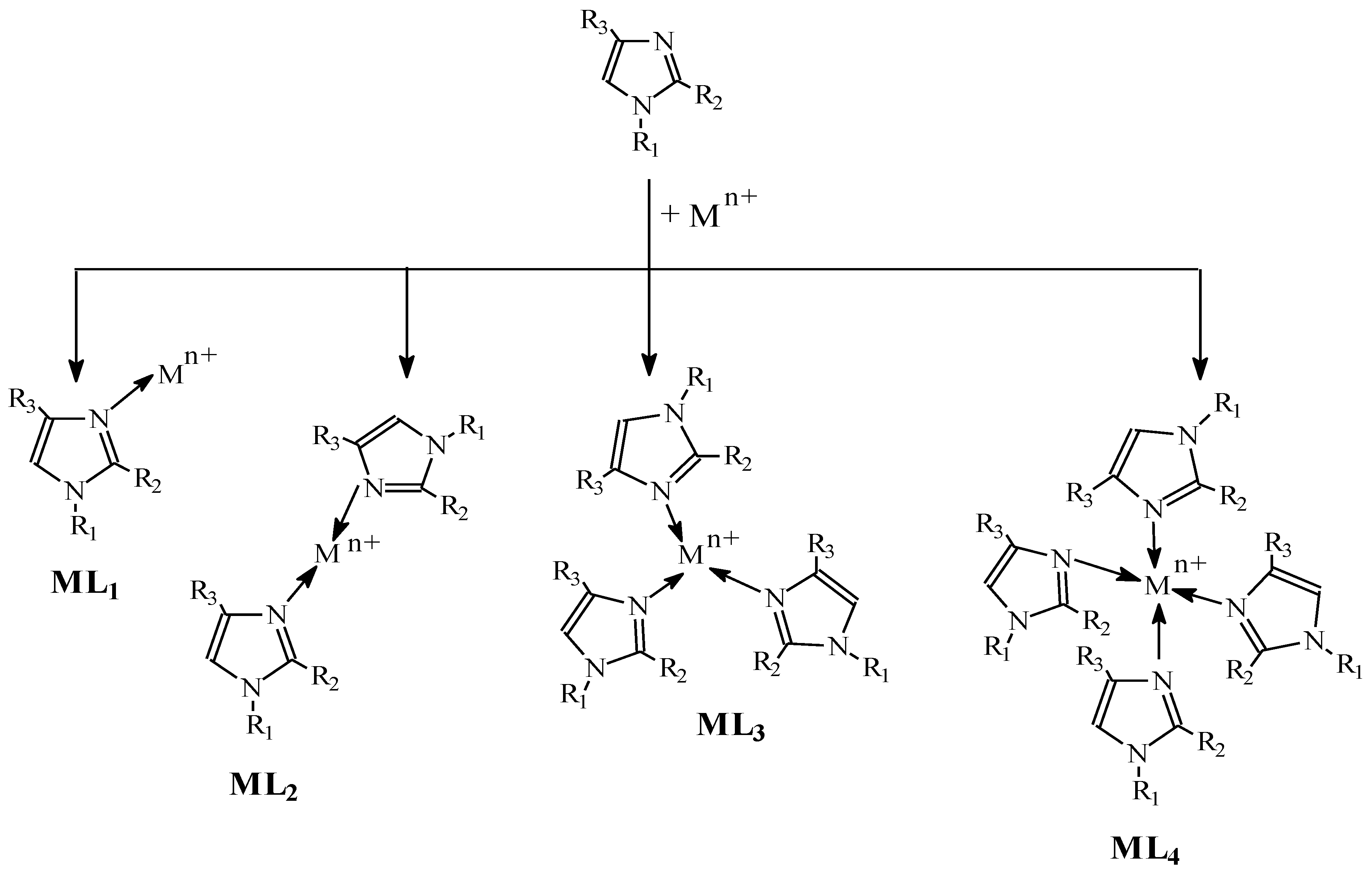

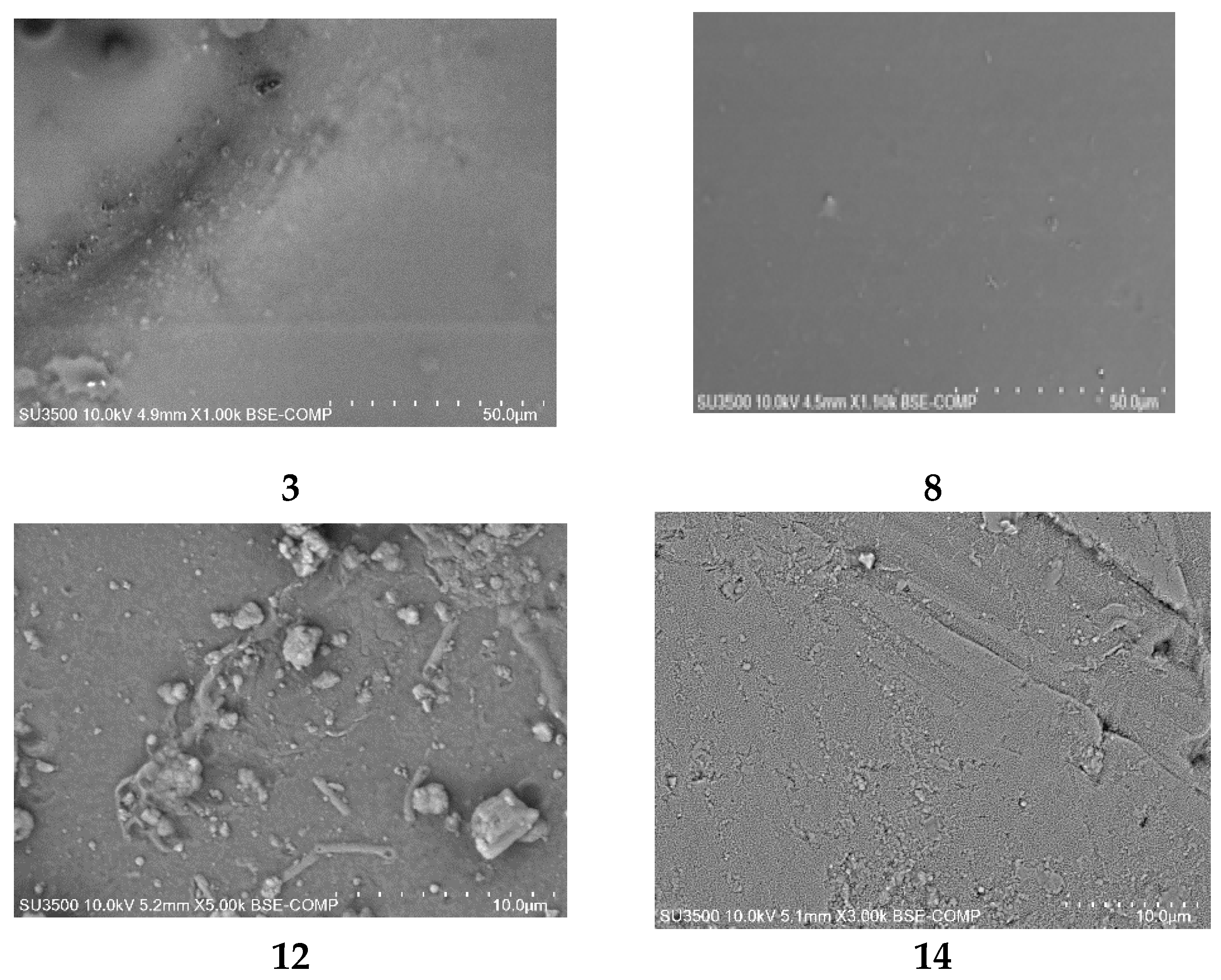
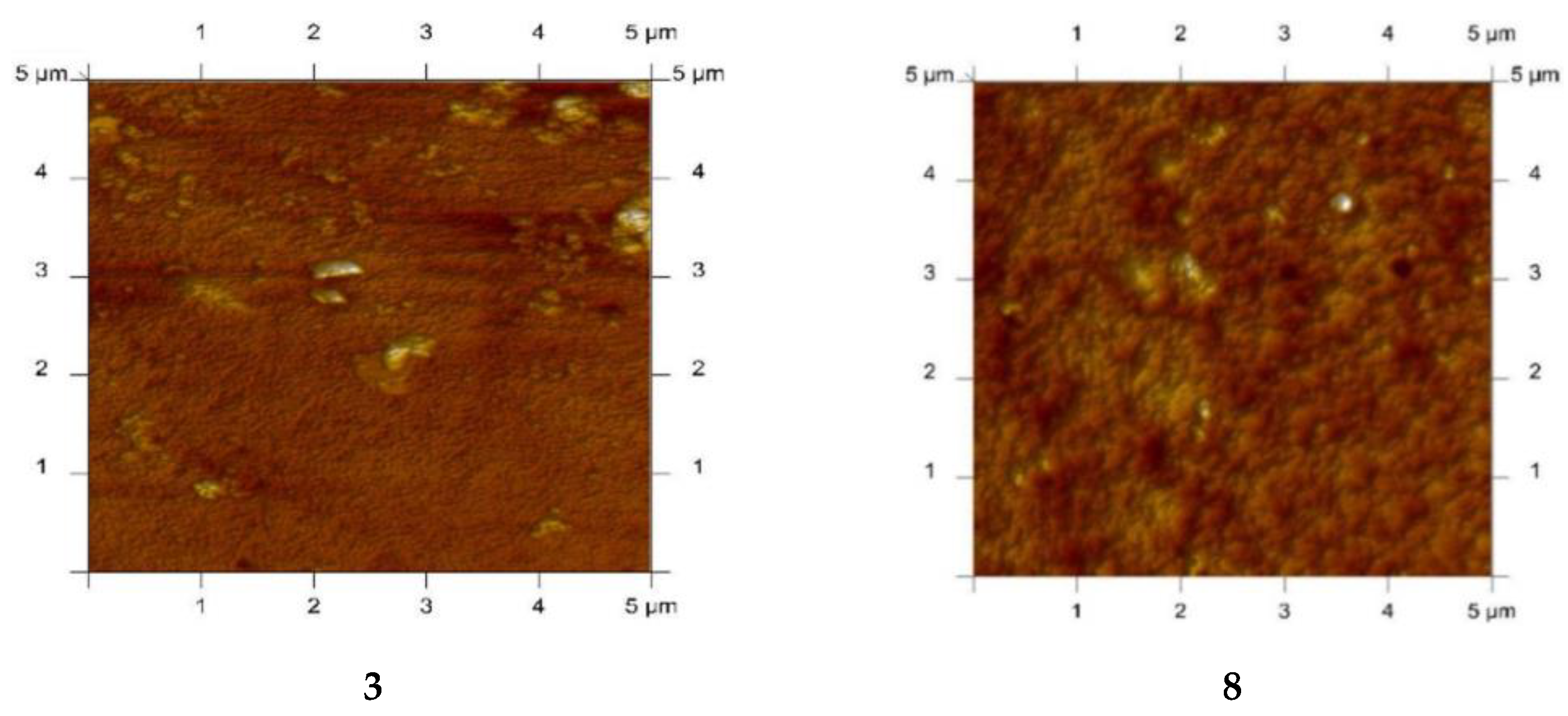
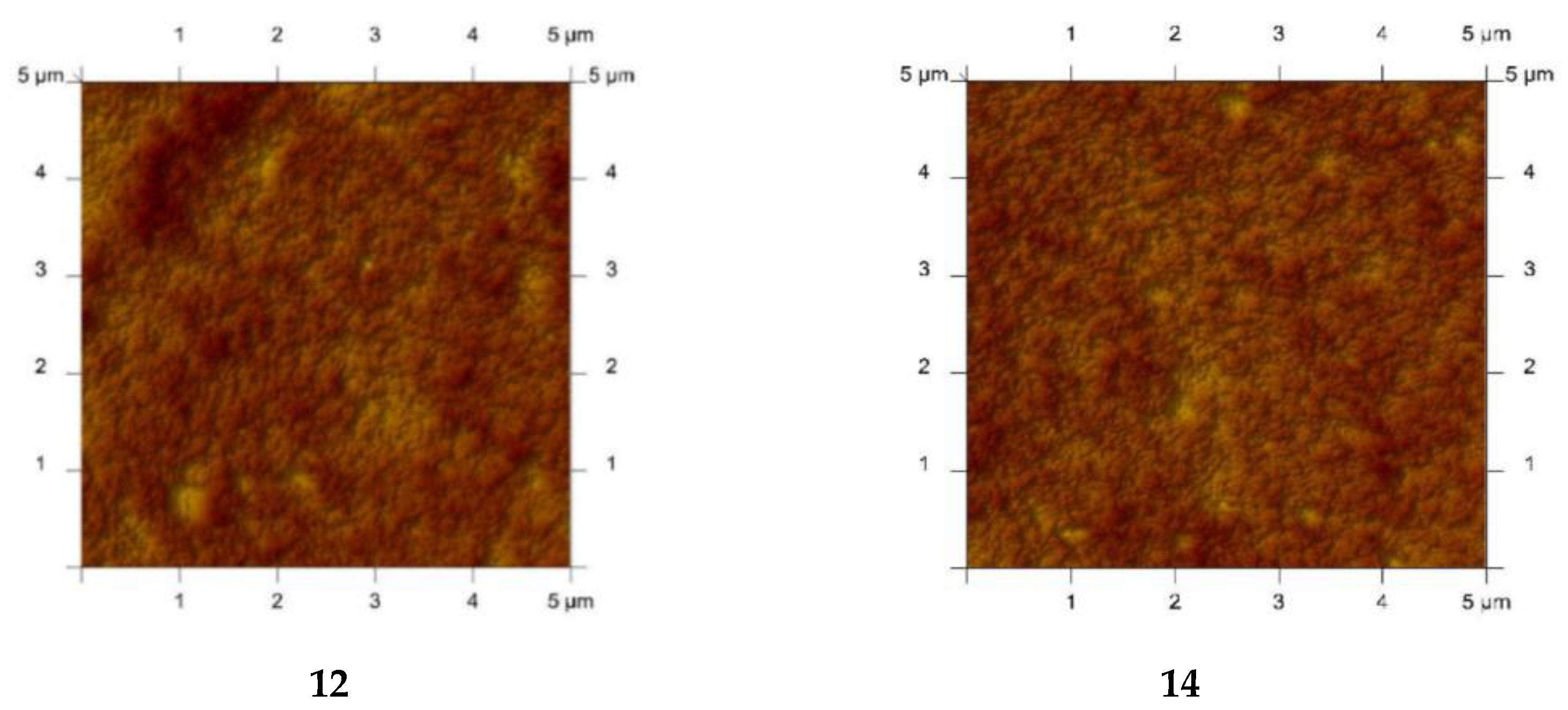
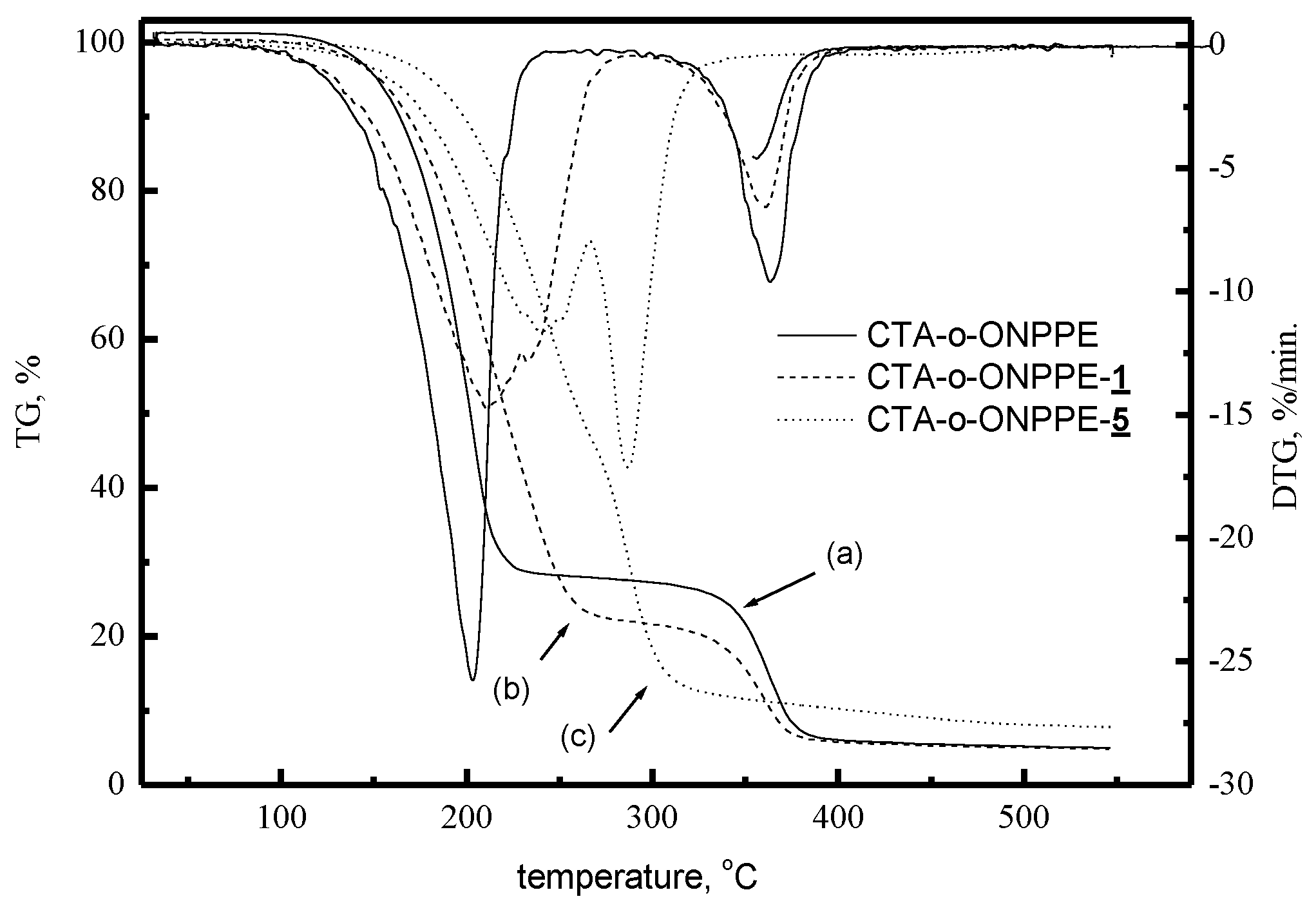

| Homologous Series | Linear Equation for Basicity pKa = an + b |
|---|---|
| 1-alkylimidazole | pKa = 0.0222 n + 7.165 |
| 1,2-dialkylimidazole | pKa = 0.0432 n + 8.01 |
| 1,2,4-trialkylimidazole | pKa = 0.0503 n + 8.46 |
| 1,4-dialkylimidazole | pKa = 0.0279 n + 7.79 |
| 2-alkylimidazole | pKa = 0.0349 n + 7.87 |
| log βn | Co(II) [35] | Ni(II) [31] | Cu(II) [39] | Zn(II) [38] |
|---|---|---|---|---|
| log β1 | y = 0.302x + 1.653 | y = 0.161x + 2.631 | 4.15 | y = 0.229x + 1.986 |
| log β2 | y = 0.342x + 2.592 | y = 0.164x + 4.790 | 7.57 | y = 0.229x + 4.500 |
| log β3 | y = 0.377x + 3.881 | y = 0.164x + 6.233 | - | y = 0.229x + 5.700 |
| log β4 | y = 0.434x + 4.780 | y = 0.166x + 5.653 | - | - |
| Carrier | Metal Ion | log β1 | log β2 | log β3 | log β4 |
|---|---|---|---|---|---|
| 1-hexyl-2-methylimidazole (6) | Co(II) | 1.96 | 2.18 | 3.02 | 5.61 |
| Cu(II) | 3.52 | 6.63 | 8.98 | - | |
| Zn(II) | 3.48 | 5.80 | 8.30 | 10.10 | |
| 1-octyl-2-methylimidazole (8) | Co(II) | 1.94 | 2.14 | 3.06 | 5.70 |
| Cu(II) | 3.53 | 6.65 | 9.65 | - | |
| Zn(II) | 4.45 | 6.80 | 9.10 | - | |
| 1-decyl-2-methylimidazole (9) | Co(II) | 1.95 | 2.21 | 3.16 | 5.76 |
| Cu(II) | 3.54 | 6.68 | 9.44 | - | |
| Zn(II) | 5.10 | 7.75 | 9.90 | - |
| Carrier | Metal Ion | log β1 | log β2 | log β3 | log β4 |
|---|---|---|---|---|---|
| 1-hexyl-4-methylimidazole (10) | Co(II) [43] | 1.25 | 2.04 | 3.02 | 5.61 |
| Cu(II) [50] | 3.72 | 4.55 | 6.53 | - | |
| Zn(II) [42] | 2.95 | 5.60 | 6.30 | - | |
| Cd(II) [42] | 2.20 | 3.93 | 5.11 | 5.81 | |
| Ni(II) [71] | 1.04 | 1.51 | 2.32 | 3.05 | |
| 1-octyl-4-methylimidazole (12) | Co(II) [43] | 1.34 | 2.14 | 3.28 | 5.79 |
| Cu(II) [50] | 3.85 | 4.49 | 6.57 | - | |
| Zn(II) [42] | 2.04 | 3.50 | 6.20 | 6.90 | |
| Cd(II) [37] | 1.26 | 2.20 | 2.93 | 3.91 | |
| Ni(II) [37] | 0.69 | 1.04 | 2.00 | 2.92 | |
| 1-decyl-4-methylimidazole (13) | Co(II) [43] | 1.40 | 2.95 | 3.60 | 5.83 |
| Cu(II) [50] | 3.94 | 4.53 | 6.60 | - | |
| Zn(II) [42] | 4.30 | 6.90 | 7.70 | 12.50 | |
| Cd(II) [65] | 1.45 | 2.25 | 2.48 | 3.14 | |
| Ni(II) [65] | 0.55 | 0.86 | 1.48 | - |
| Carrier | Metal Ion | log β1 | log β2 | log β3 | log β4 |
|---|---|---|---|---|---|
| 1-octyl-2,4-dimethylimidazole (14) [61] | Zn(II) | 1.65 | 2.17 | 4.48 | 6.39 |
| Cd(II) | 1.17 | 2.53 | 4.21 | 5.68 | |
| Ni(II) | 0.09 | 0.22 | 1.11 | 2.05 | |
| 1-decyl-2,4-dimethylimidazole (15) [69] | Zn(II) | 2.17 | 4.48 | 6.39 | 9.87 |
| Cd(II) | 2.53 | 4.21 | 5.68 | 7.56 |
| Carriers | Target Solutions | Solution | Cu(II) Initial Flux, J0, 10−6 mol/m2s | Ref. | |
|---|---|---|---|---|---|
| 1-alkylimidazole | 1–5 | Cu–Zn–Co–Ni | chloride | 4.28–6.36 | [59] |
| 1–5 | Cu–Zn–Co–Ni | nitrate | 5.16–7.03 | [57] | |
| 2 | Cu–Zn–Co–Ni | nitrate | 3.86 | [58] | |
| 1-alkyl-2-methylimidazole | 6, 8, 9 | Cu–Zn–Co–Ni | nitrate | 1.98–2.42 | [63] |
| 6 | Cu–Zn–Co–Ni | nitrate | 1.15 | [64] | |
| 7 | Cu–Zn–Co–Ni | nitrate | 2.27 | [58] | |
| 9 | Cu–Zn–Co–Ni | nitrate | 2.35 | [65] | |
| 1-alkyl-4-methylimidazole | 11 | Cu–Zn–Co–Ni | nitrate | 2.43 | [58] |
| Separation Coefficients Cu(II)/M(II) | |||||||||||
|---|---|---|---|---|---|---|---|---|---|---|---|
| Nitrate Solutions | Chloride Solutions | ||||||||||
| Carrier | Zn | Co | Ni | Ref. | Carrier | Zn | Co | Ni | Ref. | ||
| 1-alkylimidazole | 1 | 4.3 | 39.7 | 46.9 | [57] | 1-alkyl-imidazole | 1 | 3.7 | 17.8 | 35.7 | [59] |
| 2 | 4.3 | 30.4 | 39.1 | [57] | 2 | 3.6 | 9.0 | 26.4 | [59] | ||
| 3 | 3.7 | 22.6 | 33.2 | [57] | 3 | 3.2 | 21.6 | 24.8 | [59] | ||
| 4 | 3.6 | 21.9 | 29.2 | [57] | 4 | 3.1 | 29.8 | 34.5 | [59] | ||
| 5 | 3.5 | 22.0 | 22.7 | [57] | 5 | 3.0 | 14.8 | 15.5 | [59] | ||
| 1-alkyl-2-methylimidazole | 6 | 3.9 | 24.8 | 59.1 | [63] | ||||||
| 7 | 3.1 | 15.1 | 35.1 | [58] | |||||||
| 8 | 4.0 | 14.5 | 36.3 | [63] | |||||||
| 9 | 2.8 | 12.1 | 38.0 | [63] | |||||||
| 1-alkyl-4-methylimidazole | 11 | 2.8 | 11.6 | 32.8 | [58] | ||||||
| Alkylimidazole | |||||||
|---|---|---|---|---|---|---|---|
| Carrier | 1 | 2 | 6 | 7 | 8 | 9 | 11 |
| RF, % | 99.4 | 98.0 | 83.2 | 95.0 | 86.5 | 94.5 | 93.0 |
| Ref. | [57] | [57] | [63] | [58] | [63] | [63] | [58] |
| Carriers | Target Solutions | Solution | Zn(II) Initial Flux, J0, 10−6 mol/m2s | Ref. | |
|---|---|---|---|---|---|
| 1-alkylimidazole | 1–5 | Co–Ni–Zn | nitrate | 1.79–2.50 | [60] |
| 1–5 | Zn–Mn | sulphate | 1.97–2.65 | [62] | |
| 3 | Zn–Cd–Ni | nitrate | 10.76 | [61] | |
| 1-alkyl-2-methylimidazole | 8 | Zn–Cd–Ni | nitrate | 8.49 | [61] |
| 9 | Zn–Cd | nitrate | - | [69] | |
| 1-alkyl-4-methylimidazole | 10 | Zn–Cd–Co–Ni | chloride | 3.64 | [67] |
| 10 | Zn–Cd | chloride | 3.85 | [67] | |
| 10 | Zn–Cd–Co | chloride | 3.73 | [67] | |
| 12 | Zn–Cd–Ni | nitrate | 8.97 | [61] | |
| 12 | Zn from waste | chloride | - | [68] | |
| 13 | Zn–Cd–Co–Ni | chloride | 3.72 | [66] | |
| 13 | Zn–Co | chloride | 4.10 | [66] | |
| 13 | Zn–Cd | chloride | 3.89 | [66] | |
| 13 | Zn–Ni | chloride | 4.25 | [66] | |
| 13 | Zn–Cd | nitrate | 8.79 | [69] | |
| 1-alkilo-2,4-dimethylimidazole | 14 | Zn–Cd–Ni | nitrate | 25.44 | [61] |
| 15 | Cd–Zn | nitrate | 25.44 | [69] | |
| Separation Coefficients SZn(II)/M(II) | |||||
|---|---|---|---|---|---|
| Chloride Solutions | |||||
| Carrier | Cd(II) | Co(II) | Ni(II) | Ref. | |
| 1-alkyl-4-methylimidazole | 10 | 12.9 | 23.4 | 40.8 | [67] |
| 13 | 11.6 | 24.8 | 33.8 | [66] | |
| Separation Coefficients Zn(II)/M(II) | |||||
|---|---|---|---|---|---|
| Carrier | Solution | Co | Ni | Ref. | |
| 1-alkylimidazole | 1 | nitrate | 9.4 | 11.9 | [60] |
| 2 | 7.4 | 9.3 | [60] | ||
| 3 | 6.9 | 8.1 | [60] | ||
| 4 | 6.7 | 7.0 | [60] | ||
| 5 | 6.4 | 7.8 | [60] | ||
| 1-alkyl-4-methylimidazole | 10 | chloride | 9.8 | 24.9 | [67] |
| Separation Coefficients Zn(II)/M(II) | ||||
|---|---|---|---|---|
| Carrier | Mixture | Solution | SZn(II)/M(II) | Ref. |
| 1 | Zn–Mn | sulphate | 19.7 | [62] |
| 2 | Zn–Mn | sulphate | 15.7 | [62] |
| 3 | Zn–Mn | sulphate | 14.2 | [62] |
| 4 | Zn–Mn | sulphate | 12.8 | [62] |
| 5 | Zn–Mn | sulphate | 11.0 | [62] |
| 13 | Zn–Cd | chloride | 7.9 | [66] |
| 10 | Zn–Cd | chloride | 9.4 | [67] |
| 9 | Zn–Cd | nitrate | 10.8 | [69] |
| 13 | Zn–Cd | nitrate | 9.9 | [69] |
| 15 | Zn–Cd | nitrate | 24.7 | [69] |
| 13 | Zn–Co | chloride | 27.3 | [66] |
| 13 | Zn–Ni | chloride | 22.4 | [66] |
| 12 | Zn–Ni | chloride | 30.6 | [68] |
| 12 | Zn–Ni | sulphate | 29.9 | [68] |
| Mixture | Zn–Co | Zn–Mn | Zn–Cd | |||||||
| Carrier | 1 | 5 | 1 | 2 | 3 | 4 | 5 | 9 | 13 | 15 |
| RF, % | 89 | 96 | 83 | 85 | 87 | 90 | 92.5 | 87 | 83 | 94 |
| Ref. | [60] | [62] | [69] | |||||||
| Mixture | Zn–Co–Ni | Zn–Cd–Ni | Zn–Cd–Co–Ni | |||||||
| Carrier | 1 | 5 | 3 | 8 | 12 | 14 | 5 | |||
| RF, % | 76 | 87 | 87 | 92 | 94 | 95.5 | 96.9 | |||
| Ref. | [60] | [61] | [66] | |||||||
| Carrier | Effective Pore Size, µm | Tortuosity (τ) | Roughness (Rq), nm | Porosity, % | Ref. |
|---|---|---|---|---|---|
| 1 | - | 2.42 | 3.9 | 24.2 | [59] |
| 1 | 0.050 | 2.32 | 5.9 | - | [62] |
| 2 | - | - | 3.9 | 21.1 | [58] |
| 2 | 0.053 | 2.35 | 6.1 | - | [62] |
| 3 | 0.054 | 2.38 | 6.5 | - | [62] |
| 4 | 0.055 | 2.64 | 6.7 | - | [62] |
| 5 | 0.057 | 2.81 | 7.2 | 18.1 | [69] |
| 6 | 0.060 | 2.83 | 2.2 | 16.0 | [64] |
| 7 | - | - | 2.4 | 16.3 | [58] |
| 8 | 0.054 | 2.38 | 6.1 | - | [61] |
| 9 | 0.060 | 2.85 | 6.7 | 16.0 | [69] |
| 10 | 0.061 | 2.83 | 6.6 | 15.8 | [67] |
| 11 | - | - | 2.7 | 18.9 | [58] |
| 12 | 0.058 | 2.75 | 6.5 | - | [61] |
| 13 | 0.060 | 2.85 | 6.7 | - | [66] |
| 14 | 0.062 | 2.60 | 6.0 | - | [61] |
| 15 | 0.065 | 2.45 | 5.8 | 23.7 | [69] |
| Carrier | The First Step | The Second Step | Ref. | ||
|---|---|---|---|---|---|
| Temp. °C | Weight Loss, % | Temp. °C | Weight Loss, % | ||
| 1 | 211.3 | 74.63 | 360.7 | 13.90 | [57,60] |
| 5 | 227.7 | 61.30 | 358.6 | 18.90 | [60] |
| 9 | 251.3 | 80.09 | 359.1 | 5.12 | [65] |
| 10 | 220.1 | 80.57 | 327.0 | 5.88 | [67] |
| 12 | 230.0 | 80.00 | 370.0 | 15.00 | [68] |
| 13 | 230.3 | 79.14 | 342.4 | 7.46 | [66] |
| Carrier | Cations | Permeability (P), m/s | Diffusion Coefficients D0, cm2/s | Normalized Diffusion Coefficients D0,n, cm2/s | Ref. |
|---|---|---|---|---|---|
| 1 | Cu(II) | 4.28 × 10−3 | 3.44 × 10−11 | 4.17 × 10−10 | [59] |
| Zn(II) | 1.17 × 10−3 | 2.18 × 10−11 | 2.64 × 10−10 | ||
| Co(II) | 0.24 × 10−3 | 5.17 × 10−12 | 6.26 × 10−11 | ||
| Ni(II) | 0.12 × 10−3 | 3.03 × 10−12 | 3.67 × 10−11 | ||
| 6 | Cu(II) | 3.86 × 10−3 | 3.02 × 10−11 | 1.75 × 10−12 | [63] |
| Zn(II) | 1.10 × 10−3 | 1.94 × 10−11 | 1.12 × 10−12 | ||
| Co(II) | 4.04 × 10−4 | 1.01 × 10−11 | 5.86 × 10−13 | ||
| Ni(II) | 3.08 × 10−4 | 7.70 × 10−12 | 4.43 × 10−13 | ||
| 3 | Zn(II) | - | 2.04 × 10−8 | 2.11 × 10−9 | [61] |
| Cd(II) | - | 7.16 × 10−9 | 7.40 × 10−10 | ||
| Ni(II) | - | 4.39 × 10−11 | 4.53 × 10−12 | ||
| 8 | Zn(II) | - | 1.92 × 10−8 | 2.01 × 10−9 | [61] |
| Cd(II) | - | 6.76 × 10−9 | 7.14 × 10−10 | ||
| Ni(II) | - | 4.15 × 10−11 | 4.27 × 10−12 | ||
| 12 | Zn(II) | - | 1.72 × 10−8 | 1.98 × 10−9 | [61] |
| Cd(II) | - | 6.34 × 10−9 | 6.75 × 10−10 | ||
| Ni(II) | 4.59 × 10−11 | 4.83 × 10−12 | |||
| 14 | Zn(II) | - | 1.53 × 10−8 | 1.74 × 10−9 | [61] |
| Cd(II) | - | 6.06 × 10−9 | 6.58 × 10−10 | ||
| Ni(II) | - | 4.72 × 10−11 | 4.91 × 10−12 | ||
| 10 | Zn(II) | - | 6.94 × 10−9 | 3.85 × 10−10 | [67] |
| Cd(II) | - | 1.56 × 10−10 | 8.66 × 10−12 | ||
| Co(II) | - | 8.16 × 10−11 | 4.28 × 10−12 | ||
| Ni(II) | - | 7.71 × 10−11 | 4.53 × 10−12 |
Publisher’s Note: MDPI stays neutral with regard to jurisdictional claims in published maps and institutional affiliations. |
© 2020 by the authors. Licensee MDPI, Basel, Switzerland. This article is an open access article distributed under the terms and conditions of the Creative Commons Attribution (CC BY) license (http://creativecommons.org/licenses/by/4.0/).
Share and Cite
Ulewicz, M.; Radzyminska-Lenarcik, E. Application of Hydrophobic Alkylimidazoles in the Separation of Non-Ferrous Metal Ions across Plasticised Membranes—A Review. Membranes 2020, 10, 331. https://doi.org/10.3390/membranes10110331
Ulewicz M, Radzyminska-Lenarcik E. Application of Hydrophobic Alkylimidazoles in the Separation of Non-Ferrous Metal Ions across Plasticised Membranes—A Review. Membranes. 2020; 10(11):331. https://doi.org/10.3390/membranes10110331
Chicago/Turabian StyleUlewicz, Malgorzata, and Elzbieta Radzyminska-Lenarcik. 2020. "Application of Hydrophobic Alkylimidazoles in the Separation of Non-Ferrous Metal Ions across Plasticised Membranes—A Review" Membranes 10, no. 11: 331. https://doi.org/10.3390/membranes10110331
APA StyleUlewicz, M., & Radzyminska-Lenarcik, E. (2020). Application of Hydrophobic Alkylimidazoles in the Separation of Non-Ferrous Metal Ions across Plasticised Membranes—A Review. Membranes, 10(11), 331. https://doi.org/10.3390/membranes10110331





